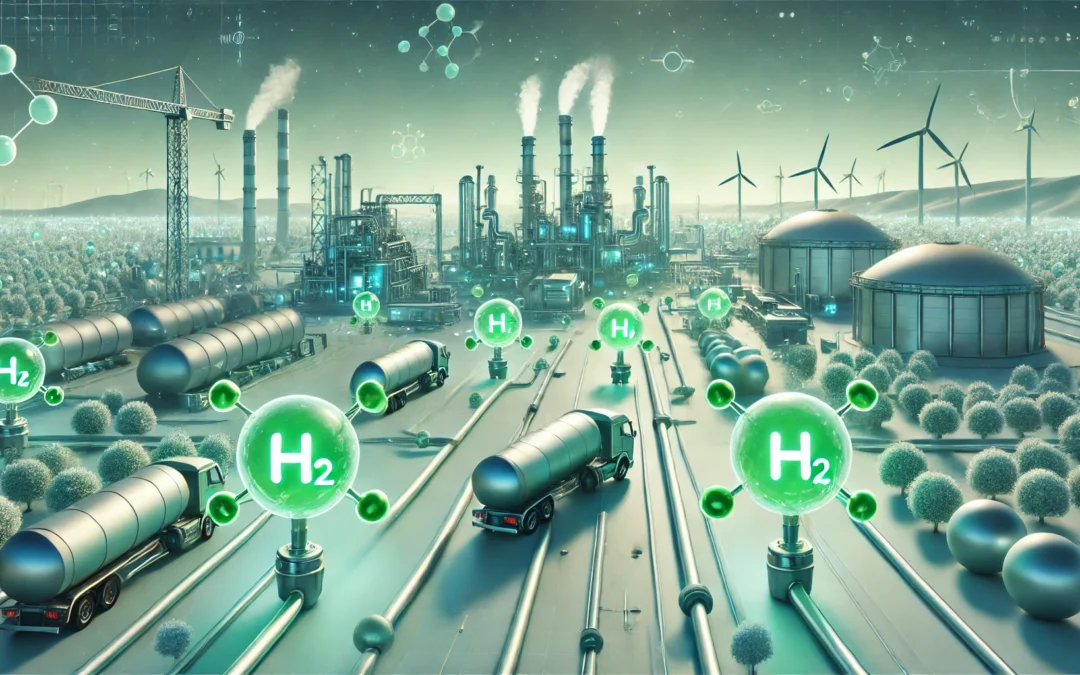In the transition to a more sustainable world, green hydrogen has emerged as an essential resource to decarbonise key sectors such as industry and transport. In 2024, the European Union and other countries have redoubled their efforts with historic investments to build infrastructure and promote the production of renewable hydrogen, which will be crucial to meeting climate targets. This investment underlines the key role of green hydrogen in combating climate change and creating a carbon-free economy.
Green hydrogen, unlike conventional hydrogen, is generated from renewable energy-based technologies (e.g. from electrolytic cells combined with renewable energies such as wind or solar) without emitting polluting gases. This process makes it a clean and safe option for reducing global emissions. However, its mass adoption depends on successful transport and storage challenges, and this is where hydrogen carrier molecules play an essential role.
Hydrogen carrier molecules or ‘green molecules’: the key to the development of the green H2 sector.

Hydrogen in its pure state is difficult to store and transport because of its low energy density and because it requires special pressure and temperature conditions. Carrier molecules, such as methanol, ammonia and formic acid, allow hydrogen to be stored safely and stably, making it easier to handle and transport. These molecules act as ‘packaging’ for the hydrogen, which can be released at the point of consumption without logistical complications.
Methanol, a versatile carrier, is obtained by combining green hydrogen with captured CO₂, and can be practically reconverted to hydrogen at the point of use. Ammonia is another promising carrier, with a high hydrogen density and an existing transport infrastructure, making it ideal for large-scale industrial applications. The lesser-known formic acid is easy to handle and an excellent choice for smaller applications, such as fuel cells in light-duty vehicles.
Applications of H2 and its derivatives in transport and industry
The flexibility of these carrier molecules opens up a wide range of applications. In the transport sector, they can be used in trucks, trains and buses, enabling carbon-free mobility. This year we have seen the first hydrogen buses operating in Germany, and Japan has launched hydrogen trains, showing the potential of hydrogen in sustainable public transport. Carrier molecules make storing and refuelling green hydrogen more practical, helping to reduce dependence on fossil fuels over long distances.

In industry, green hydrogen and its carriers are viable alternatives to replace coal in high-temperature processes, such as steel production, and as a feedstock in the chemical industry, where green hydrogen replaces grey hydrogen in the production of ammonia and methanol, essential chemicals in the manufacture of fertilisers and plastics.
In addition, green hydrogen is also key to energy storage. With the growth of renewable energies such as solar and wind, efficient methods are needed to store excess energy and release it when needed. Surplus renewable energy can be converted into green hydrogen and stored in carriers such as methanol or ammonia, which can then be converted back into energy when demand is high or renewable generation is low. This helps to make the electricity grid more stable and sustainable, and reduces the intermittency of renewable sources.
The challenges and opportunities that the immediate future of green H2 and its derived ‘molecules’ brings us
Despite its potential, green hydrogen still faces significant challenges. One of these is the cost of production, which remains high compared to fossil fuels. However, technological progress and government support are reducing these costs, with expectations that green hydrogen will become more accessible in the coming years. In addition, investments in distribution infrastructure and refuelling stations are needed to bring green hydrogen to scale, enabling its use in industrial and transport applications around the world.
CARTIF’s Biotechnology and Sustainable Chemistry Area is also developing technologies to make the production of green hydrogen more efficient and economical, reducing the costs of electrolysis and improving materials for the safe storage of hydrogen in carrier molecules. These advances bring these technologies closer to commercial scale, making green hydrogen competitive and accessible in an energy market that increasingly demands sustainability. Through projects such as CATCO2NVERS and H2METAMO, we are working on capturing CO₂ for conversion into green methanol, a high value-added hydrogen carrier. These projects not only investigate how methanol and ammonia can facilitate hydrogen storage and transport, but also explore the potential of these carriers for direct use in industrial and energy applications.
“At CARTIF, we are pioneers in green hydrogen and its chemical storage in the form of green molecules and are committed to the advancement of green hydrogen and its carriers as a solution for a low carbon economy.”
In short, green hydrogen and its derivatives are beginning to transform the way we think about energy. This resource represents a unique opportunity to reduce carbon emissions and provide clean energy in a variety of industries and applications. At CARTIF, we believe that green hydrogen is the path to a sustainable future and we are committed to developing technologies that enable its mass adoption to have a positive impact on the planet.
Co-author
David Díez Rodríguez. Researcher at the Biotechnology and Sustainable Chemistry area.
- Circular bioprocesses: how to transform waste into high-value bioproducts - 31 October 2025
- The green molecule revolution - 15 November 2024
- Biogenic CO2: challenges and opportunities for a sustainable future - 19 April 2024
